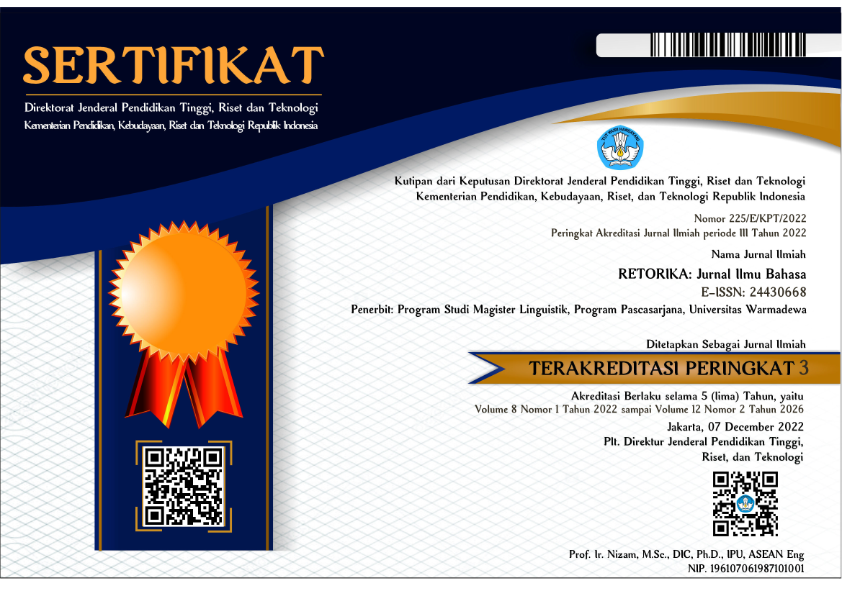Meme Implicature Using the Word 'Tenggelamkan'
Abstract
The majority of Indonesians who are known to use social media as a means of communication and entertainment are certainly familiar with the term meme. A meme phenomenon popular is the use of the word 'tenggelamkan' at the end of the discourse popularized by Susi Pudjiastuti, the former minister of fisheries and maritime affairs. The objectives of this study are as follows: (1) to determine the language style used in memes that use the word ‘tenggelamkan’ and (2) to determine the implicature of memes using the word ‘tenggelamkan’. The data source of this research is taken from various pictures on the internet, amounting to 15 memes. The data collection used is the method capture. The research method is descriptive qualitative, the analysis used is Grice's theory of conversational maxims. The results of this study indicate the themes used in memes using the word ‘tenggelamkan’ include the themes of love, friendship, corruption, worship, and food. The use of language styles that are reflected, such as 9 memes of cynicism, 5 memes of paradox, and 1 meme of rhetoric. The implicatures of meme data using the word ‘tenggelamkan’ are as follows: satire, suggestion, satire and suggestion.
References
Blackmore, S. (2019). Gene and meme. Encyclopedia of Animal Behavior, 67–74.
Dawkins, R. (1989). The Selfish Gene. Oxford: Oxford University Press.
Grice, H. (1975). Logic and Conversation ’in Syntax and Semantics, Speech Act (3rd ed.). New York: Academic Press.
Grundlingh, L. (2018). Memes as speech acts. Social Semiotics, 28(2), 147–168.
Harlow, S., Rowlett, J. T., & Huse, L. K. (2020). ‘Kim Davis be like … ’: a feminist critique of gender humor in online political memes. Information Communication and Society, 23(7), 1057–1073.
Hirsch, G. (2019). Hitler’s out of Dope: A cross-cultural examination of humorous memes. Journal of Pragmatics, 149, 25–39.
KBBI, P. B. (2008). Kamus Bahasa Indonesia. Jakarta: Departemen Pendidikan Nasional.
Lyons, J. (1993). Linguistic Semantics an Introduction. Cambridge: CUP.
Nee, R. C., & De Maio, M. (2019). A ‘Presidential Look’? An Analysis of Gender Framing in 2016 Persuasive Memes of Hillary Clinton. Journal of Broadcasting and Electronic Media, 63(2), 304–321.
Piata, A. (2016). When metaphor becomes a joke: Metaphor journeys from political ads to internet memes. Journal of Pragmatics, 106, 39–56.
Setiawan, A. (1990). Teori Humor. No. 3 Tahun III. Majalah Astaga, 34–35.
Sujoko. (1982). Perilaku Manusia dalam Humor. Jakarta: Karya Pustaka.
https://www.boombastis.com/kampanye-makan-ikan-bu-susi/105165
Copyright (c) 2020 RETORIKA: Jurnal Ilmu Bahasa

This work is licensed under a Creative Commons Attribution-ShareAlike 4.0 International License.
This journal provides immediate open access to its content on the principle that making research freely available to the public supports a greater global exchange of knowledge.
All articles published Open Access will be immediately and permanently free for everyone to read and download. We are continuously working with our author communities to select the best choice of license options, currently being defined for this journal as follows: Creative Commons-Non Ceomercial-Attribution-ShareAlike (CC BY-NC-SA)
 Abstract viewed = 269 times
Abstract viewed = 269 times
 PDF downloaded = 382 times
PDF downloaded = 382 times

2.png)














